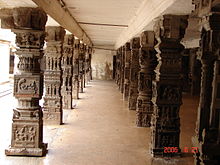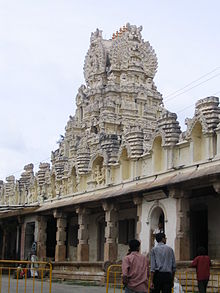- Cheluvanarayana Swamy Temple
-
Coordinates: 12°39′36.8″N 76°38′51.1″E / 12.660222°N 76.647528°E
Cheluvanarayana Swamy Temple is located in Melkote in the Mandya District, Karnataka, India. The place is also known as Thirunarayanapura. It is built on rocky hills known as Yadavagiri or Yadugiri overlooking the Cauvery valley. It is about 30 miles (48 km) from Mysore and 97 miles (156 km) from Bangalore. Mysore Road is very nice, but the road from Mysore Road towards Melukote needs improvement. Travelling in car from Mysore Road till the temple complex would take you close to 1.5 hours, so plan your visit accordingly. (as on 27th Dec 2008)
Temple complex
The temple is a square building of large dimensions but very plain, dedicated to Lord Cheluva-Narayana Swamy or Tirunarayana. The utsavamurthi, which is a metallic image, representing the deity which is called Cheluvapille Raya or Cheluvanarayana Swamy whose original name appears to have been Ramapriya. According to a legend, this metallic image was lost and was recovered by Sri Ramanujacharya. The annual report of the Mysore Archeaelogical Department states on the strength of epigraphic evidence, that the presiding deity of this temple was already a well known object of worship before Sri Ramanujacharya worshipped at the shrine in December 1098 CE. and even before he came to the Mysore region and that very probably he used his influence to rebuild or renovate the temple. From the lithic records of the period, existence of Tamil influence and Vaishnava worship in the area are also evident.[citation needed]
The temple is richly endowed, having been under the special patronage of the Mysore Rajas, and has a most valuable collection of jewels. As early as 1614, the Mysore king Raja Wodeyar (who reigned 1578–1617) who first acquired Srirangapatna and adopted the Srivaishnava faith, handed over to the temple and the Brahmins at Melkote, the estate granted to him by Vijaynagar king Venkatapati Raya. On one of the pillars of navaranga of the Narayanaswami temple is a bas relief about one and a half feet high, of Raja Wodeyar, standing with folded hands, with the name inscribed on the base. He was said to be a great devotee of the presiding deity and a constant visitor to the temple. A gold crown set with precious jewels was presented by him to the temple. This crown is known as the Raja-mudi after his name. A legend says that on the day of his death, he was observed entering the sanctum and was seen no more afterwards. From the inscriptions on some of the gold jewels and on gold and silver vessels in the temple it is learnt that they were presents from Krishnaraja Wodeyar III and his queens. Krishnaraja Wodeyar III also presented to the temple a crown set with precious jewels. It is known after him as Krishnaraja-mudi. Vairamudi or Vajramukuta, another crown of great value, seems to be older than Raja-mudi and Krishnaraja-mudi and it is not known as to who gave it to the temple.[citation needed]
All the three crowns are kept in the safe custody of the Government and brought to the temple on specific annual occasion for adoring the image of Cheluvanarayana Swamy. The vairamudi festival, which is the chief annual celebration is attended by more than 400,000 people.[citation needed]
External links
Categories:- Vishnu temples
- Hindu temples in Mandya district
- Purana temples of Vishnu
Wikimedia Foundation. 2010.


